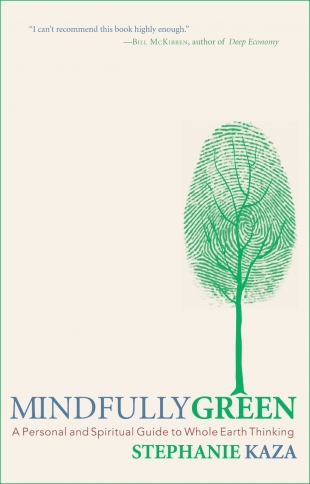Stephanie Kaza has been an environmental educator, professor, writer, and advocate for sustainability since the first Earth Day in 1970. She has also been a student of Zen Buddhism for most of her life and has benefited immensely from the principles and practices of this path. Kaza is coeditor with Kenneth Craft of Dharma Rain: Sources of Buddhist Environmentalism and editor of Hooked! Buddhist Writings on Greed, Desire, and the Urge to Consume. In this practical and enlightening paperback, she sheds light on the "green practice path" of environmental stewardship. The younger generation senses the importance of whole Earth thinking and want to save the rain forests, the whales, and the polar bears. Some businesses are making energy and waste audits to stay profitable, and voters are genuinely excited about a green jobs economy. All of these are signs of what Kaza calls "green zeal."
In the first section of the book, "Seeking Green Principles," the author probes the Buddhist ideals of reducing harm, being with and witnessing the suffering of the ecosystem and all of its parts, and embracing the deep systems view. These three principles provide a practical and philosophical foundation to the green practice path. The Dalai Lama challenges us to practice kindness as a way of not-harming. Kaza wants us to apply this to the environment by asking the following questions:
"How can we find a way to offer kindness that will reduce the suffering of trees or birds or people on the land? How can kindness mitigate conflicts between opposing parties? How can the practice of kindness make life more sustainable for those committed to environmental work?"
In the second section, "Following the Green Path," Kaza delineates what she calls a lifeway practice of green living based on clear intention, community engagement, and shared wisdom. This means looking in every situation for the green alternative that makes the most environmental sense. It means examining the ethical dimensions of your food choices, your buying patterns, your energy use, and your commitment to the greening of your community. This is not an easy path. There will be many obstacles brought on by doubt, anxiety, anger, and despair. But there are also sources of inspiration and encouragement from green activists and writers, animals, trees and plants.
The final section, "Acting on Green Values," examines three fields of green practice: conserving and maintaining energy effectively, managing the hooks of desire emanating from consumerism, and being peace in a world of constant turmoil. She recommends that we bring mindfulness to these three areas.
